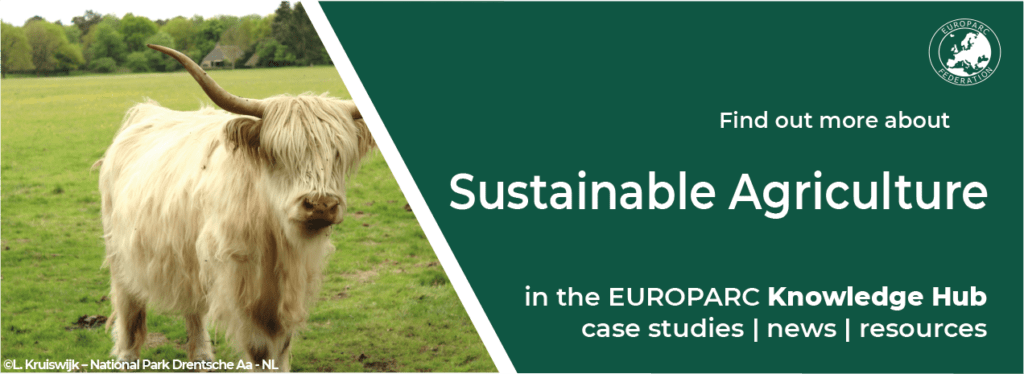Nächstes Webinar: Zukunft gemeinsam gestalten – wie Schutzgebiete durch Kooperationen die Biodiversität fördern
- 11th of November
- 14:00 CET – online
- Registrieren Sie sich hier
Der weltweite Rückgang der biologischen Vielfalt macht auch vor Europa nicht Halt. Laut jüngstem „Bericht zum Zustand der Natur“ der Europäischen Kommission aus dem Jahr 2020 stehen geschützte Arten und Lebensräumen in Europa weiterhin unter Druck. Die Gründe hierfür sind vor allem auf die weitreichende Zerstörung von Lebensräumen und die Übernutzung der Landschaft, z. B. in der Forst- und Landwirtschaft, zurückzuführen.
Offensichtlich ist, dass wir dringend handeln müssen, wenn sich Europas Biodiversität – wie in der neuen EU-Biodiversitätsstrategie vorgesehen – bis 2030 wirklich erholen soll. Großschutzgebiete wie Wildnisgebiete, Nationalparke oder Biosphärenreservate, in denen sich die Natur weitgehend ungestört von menschlichen Einflüssen entwickeln darf, sind eines der wichtigsten Mittel, um Lebensräume sowie deren Bewohner, zu schützen, zu fördern und zu erhalten. In vielen Großschutzgebieten Europas werden daher vielfältige innovative Projekte umgesetzt, die dem Schutz, der nachhaltigen Nutzung und der Entwicklung der biologischen Vielfalt dienen.
In diesem Webinar stellen wir eindrucksvolle Projekte aus Deutschland, Österreich und der Schweiz vor, die zeigen, wie Schutzgebiete mit Landwirtinnen, Behörden, Kommunen, Privatpersonen, Unternehmen und weiteren Akteuren zusammenarbeiten. Auf diese Weise wird nicht nur die biologische Vielfalt gefördert, sondern auch das gesellschaftliche Bewusstsein für den Wert und die Bedeutung der biologischen Vielfalt für Mensch, Natur und Wirtschaft gestärkt.
Programm
11th of November, 14:00 CET – online
Wilkommen und Introduktion
Esther Bossink – Communications Officer at EUROPARC Federation.
Naturschutz im Urlaub: Voluntourismus für biologische Vielfalt in den Nationalen Naturlandschaften
Anne Schierenberg – Leiterin Bürgerschaftliches Engagement bei Nationale Naturlandschaften e. V. und Projektleiterin
Mit innovativen Partnerschaften zwischen Schutzgebieten und touristischen Anbietern bauen Nationale Naturlandschaften e. V. und vier Modellgebiete (Müritz-Nationalpark, Nationalpark Schleswig-Holsteinisches Wattenmeer, Biosphärenreservat Mittelelbe und Naturpark Südschwarzwald) Voluntourismus-Angebote auf. Voluntourismus – die Verknüpfung von Urlaub mit praktischem Einsatz für die biologische Vielfalt – bietet Urlaubenden die Möglichkeit, durch Mitarbeit z. B. bei der Moorrenaturierung, der Entfernung invasiver Pflanzenarten und der Pflege von Streuobstwiesen, die Arbeit der Schutzgebiete aktiv zu unterstützen. Gleichzeitig werden die Urlaubenden für Naturschutzanliegen sensibilisiert und zu persönlichem Einsatz – auch über den Urlaub hinaus – motiviert.
BROMMI – Biosphärenreservate als Modelllandschaften für den Insektenschutz
Sonja Miller, Leiterin Unternehmenskooperationen bei Nationale Naturlandschaften e. V. und Projektreferentin „BROMMI“ & Heidi Lehmann – Projektmanagerin BROMMI im Biosphärenreservat Schorfheide-Chorin
In den UNESCO-Biosphärenreservaten Mittelelbe, Bayerische Rhön, Schaalsee, Schorfheide-Chorin und Schwarzwald geht’s in den kommenden Jahren ran an Acker und Wiese: Dort erproben und evaluieren der WWF Deutschland, die Hochschule für nachhaltige Entwicklung Eberswalde, das Leibniz-Zentrum für Agrarlandschaftsforschung (ZALF) und Nationale Naturlandschaften e. V. Lösungswege für den Schutz und die Förderung der Insektenfauna gemeinsam mit interessierten Landwirt:innen, Kommunen und vielfältigen Partner:innen der Biosphärenreservate. Im Fokus stehen dabei nicht nur die naturschutzfachlichen Potenziale der verschiedenen Insektenschutzmaßnahmen, sondern auch, wie sie sich in die Praxis der beteiligten Flächenbewirtschafter einfügen lassen und welche wirtschaftlichen Folgen sie haben.
Die BROMMI und Voluntourismus Projekte werden beiden gefördert im Bundesprogramm Biologische Vielfalt durch das Bundesamt für Naturschutz mit Mitteln des Bundesministeriums für Umwelt, Naturschutz und nukleare Sicherheit.
Invasive Neophyten bekämpfen in Kärntens Naturparken
Robert Heuberger, Manager Naturpark Dobratsch.
In Kärntens Naturparken wurde im Jahr 2013 mit einem Schwerpunktprogramm zur „Pflege“ von invasiven Neophyten begonnen. Ausgehend von einer fachlichen Kartierung ökologisch besonders wertvoller Flächen (Feuchtwiesen, Magerwiesen, Ufer- und Schilfbestände, Flachmoore) wurde ein Arbeitsplan zur Eindämmung invasiver Neophyten erstellt. Dabei wurden alle als invasiv geltende Neophytenbestände erhoben. Teil des Projekts ist die ausführliche Zusammenarbeit mit der Bevölkerung, welche maßgeblich zum hohen Erfolg beigetragen hat.
Inwertsetzung der ökologischen Infrastruktur im Naturpark Beverin
Sebastian Nagelmüller, Projektleitung Natur, Landschaft und Aufwertungsmassnahmen
Grüne Infrastruktur ist essentiell für gesunde und biodiverse Ökosysteme. Im Pilotprojekt “Ökologische Infrastruktur in Pärken” haben Schweizer Naturparke mit Erfolg zusammen mit lokalen Akteuren und Unternehmen gearbeitet, um diese Infrastrukturen zu unterhalten und entwickeln. Herr Nagelmüller wird sowohl dieses, als auch das Nachfolgeprojekt ”
Inwertsetzung der ökologischen Infrastruktur” vorstellen.
Lasst uns drüber reden…
Alle Teilnehmer haben die Möglichkeit Fragen zu stellen.
Das Webinar wird ungefähr 90 Minuten dauern und ist komplett auf Deutsch. Wir begrüßen Teilnehmer aus dem gesamten Netzwerk und darüber hinaus.
Dieses Webinar wird unterstützt von:

LIFE ENABLE Kick-off meeting
At the end of September, eight partner organisations’ representatives gathered for the first meeting within the LIFE ENABLE project: Creating the European Nature Academy for applied Blended Learning.
LIFE ENABLE
This forward-looking three-year project is designed to build practical nature management capacity among Natura 2000 and Protected Area managers. It aims to equip individuals and their organisations with the competencies they require to meet the challenges and opportunities of nature management in the coming decade. Moreover, it will establish an enabling framework to create a training system for professional development that contributes to ensuring progress towards the realisation of the objectives and ambitions of the EU Biodiversity Strategy 2030 and underpinning policies.
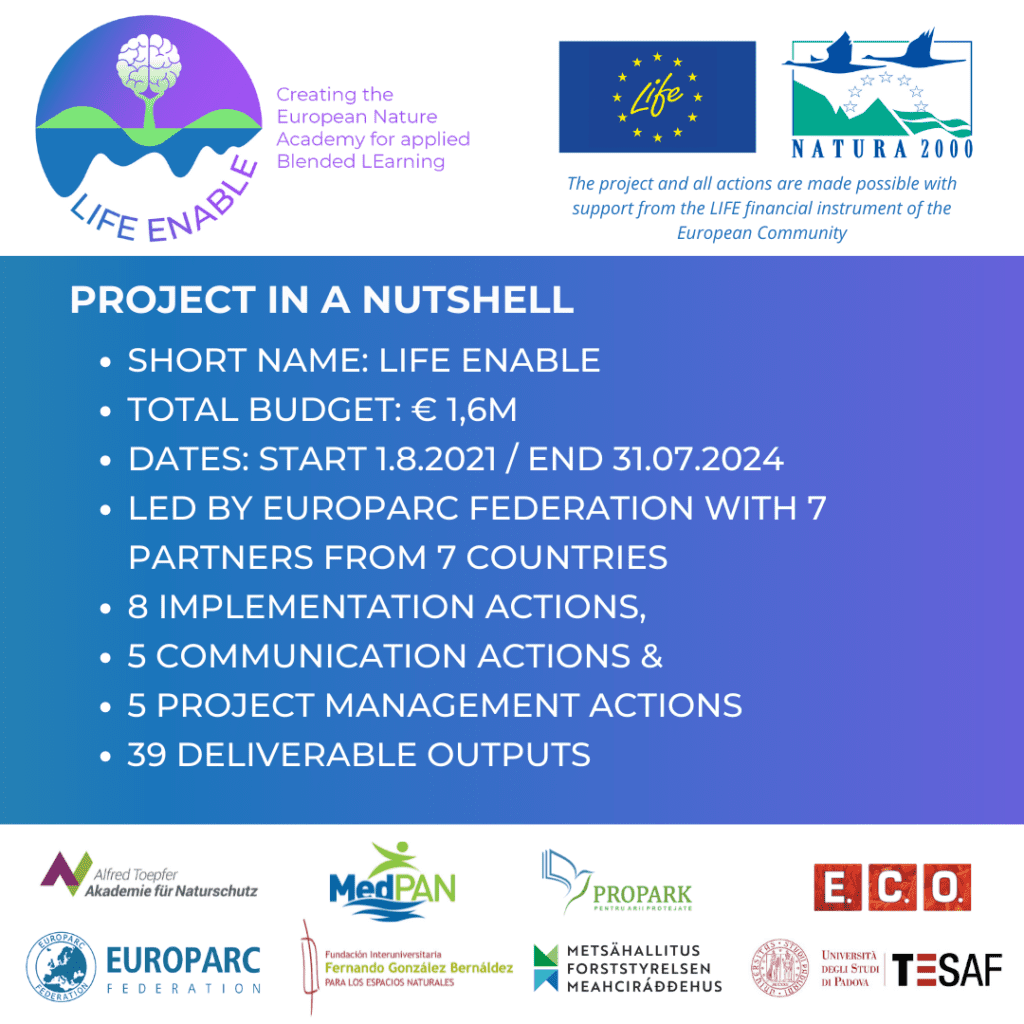
LIFE ENABLE Project in a nutshell
Kick-off meeting: main topics
Over four days, the partners had a chance to discuss the most important elements of the project. Furthermore, they were introduced to the project’s identity and got a chance to know each other better. In addition, a short survey convened during the first day of the meeting showed that the majority of partners have previous experience with LIFE projects.
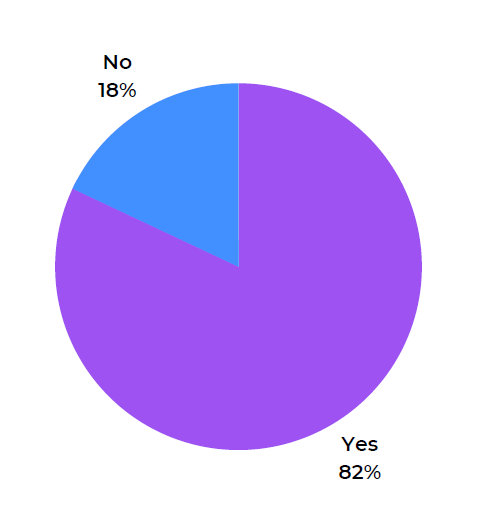
Previous experience of LIFE projects
The Kick-off meeting primarily focused on 8 Implementation actions, 5 Communication actions and 5 Project management actions, but it also brought multiple opportunities for participatory exercises paying special attention to the project’s target audiences, desired impacts and stakeholders.
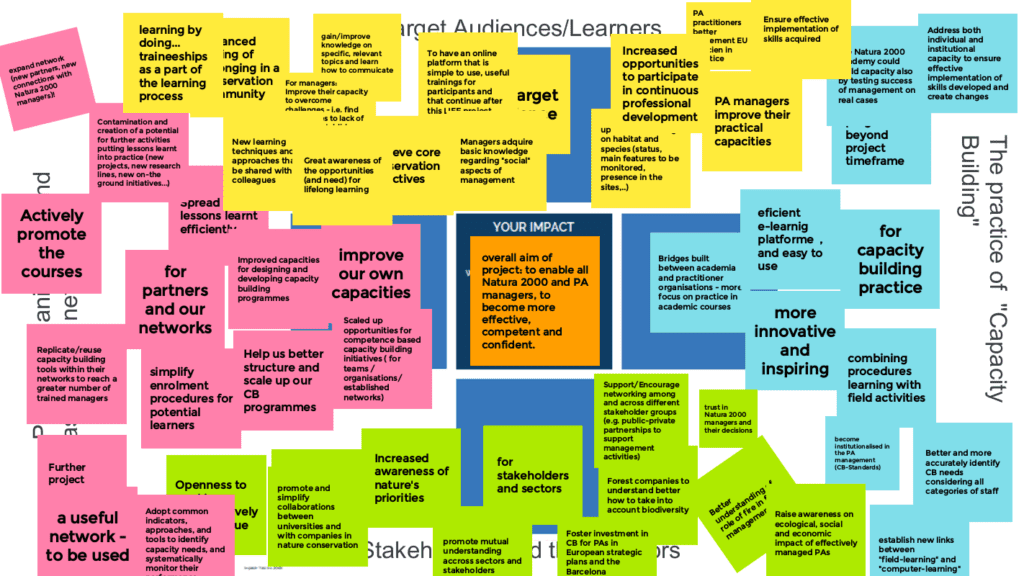
Impact Exercise LIFE ENABLE
Additionally, we were curious to hear about each other’s positive experiences and best practices that could potentially be implemented into LIFE ENABLE. Among other things, we wanted to know what makes capacity building experiences impactful.
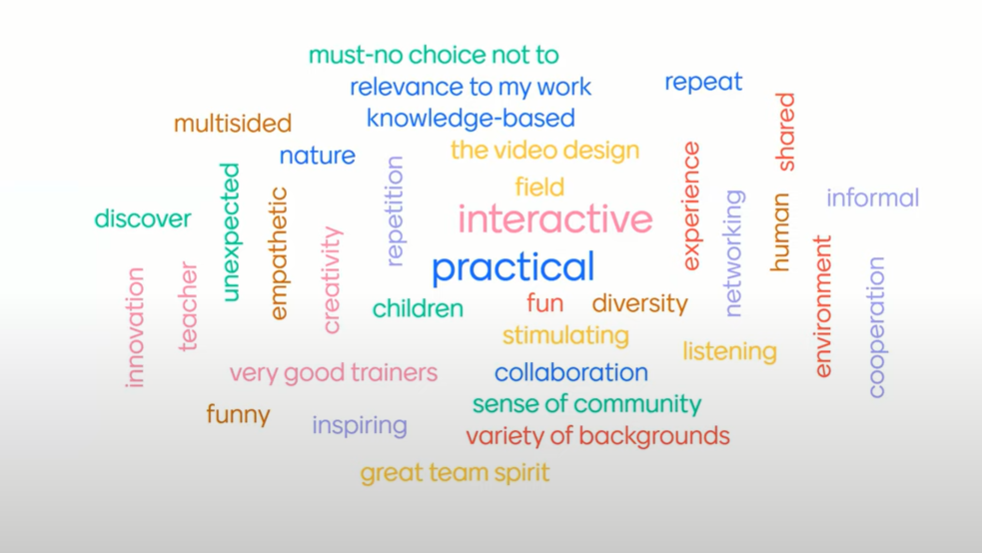
LIFE ENABLE Participatory Mentimeter exercise describing impactful capacity building experiences
We are looking forward to collaborating on this exciting project! Please regularly visit the LIFE ENABLE section of the EUROPARC website for more information!
Project partners
The LIFE ENABLE project is led by EUROPARC Federation with the support of 7 partners from 7 countries:
- Alfred Toepfer Akademie für Naturschutz
- E.C.O. Institute of Ecology
- FUNGOBE, Fundación Interuniversitaria Fernando González Bernáldez para los espacios naturales
- Metsähallitus, Parks and Wildlife Finland
- MedPAN Mediterranean Protected Areas Network
- Propark Foundation for Protected Areas
- TESAF, University of Padova, The Department of Land, Environment, Agriculture and Forestry

LIFE ENABLE project partners
Resolution on the farm to fork strategy for a fair, healthy and environmentally-friendly food system
by ArtTower, Pixabay
On October 20, 2021 the European Parliament approved the Resolution on a farm to fork strategy for a fair, healthy and environmentally-friendly food system.
After a long procedure and a debate that involved NGOs, Farmers organizations and decisions makers, the European Parliament approved on 20.10.2021 the Resolution on a farm to fork strategy for a fair, healthy and environmentally-friendly food system.
Welcoming the ambitions and goals of the Strategy, the members of the European Parliament “emphasise the inextricable links between healthy people, healthy societies, healthy animals, and a healthy planet”.
After the long debates surround the CAP, the resolution is a positive development. It highlights the need for coherence between European policies in favour of the environment and biodiversity. Indeed, the Resolution takes also into account the role of Protected Areas, emphasising the need:
- “to ensure coherence between the farm to fork strategy and the objectives of the European Green Deal;
- to maintain and enhance biodiversity for safeguarding EU and global food security;
- for coherence with the EU biodiversity strategy, including the contribution of Natura2000 and Marine Protected Areas to supporting healthy food production;
- for consistency regarding the common agricultural policy (CAP), common fisheries policy (CFP), EU trade policies and the EU bioeconomy strategy”.
By connecting the Farm to Fork Strategy to the Common Agricultural Policy, the European Parliament points out some notions that are at the core of the rural Protected Areas’ actions and of EUROPARC’s message for the new CAP, such as:
- “extensive permanent grassland-based, silvo-pastoral or extensive organic animal husbandry, often involving pastures of high environmental value, are key features of the European food system;
- quality schemes are a defining element of many traditional rural communities, allowing them to make productive use of land that otherwise would have been abandoned;
- land-based and low density agricultural production can have multiple positive effects for the environment and for the conservation of cultural landscapes, contributes to protecting rural areas from depopulation and abandonment, helps in mitigating against climate change, and contributes to a circular economy and biodiversity restoration and must therefore be supported and encouraged;
- support should be given to farms making the transition to more sustainable forms of production”.
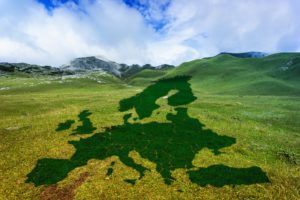
by Gerd Altmann, Pixabay
Moreover, EUROPARC welcomes that the European Parliament “calls on the Commission to only approve CAP national strategic plans which clearly demonstrate a commitment to sustainability from the economic, environmental and social perspectives and are in line with the objectives of the European Green Deal, the relevant EU-wide targets and the Paris Agreement”.
The Resolution is available here in all languages.
Read more about Farm to Fork Strategy and EUROPARC here.
SEE PROJECT: Partners gathered for the first exchange programme in Serbia
In the early stages of the SEE project, there were a number of surveys conducted in order to discover and analyse the challenges linked to outdoor sports in National Parks and Protected Areas. The project has now entered a new phase that includes several exchange programs.
From 27h to 30th of September, the SEE project partners met for the first time in the Tara National Park, EUROPARC member in Serbia.
During the event, the host – Mountaineering Association of Tara presented a very interesting pilot project, concerning the inclusion of mountaineering in the educational curriculum of schools in the area. The aim of the course is to expose children to nature from an early age.
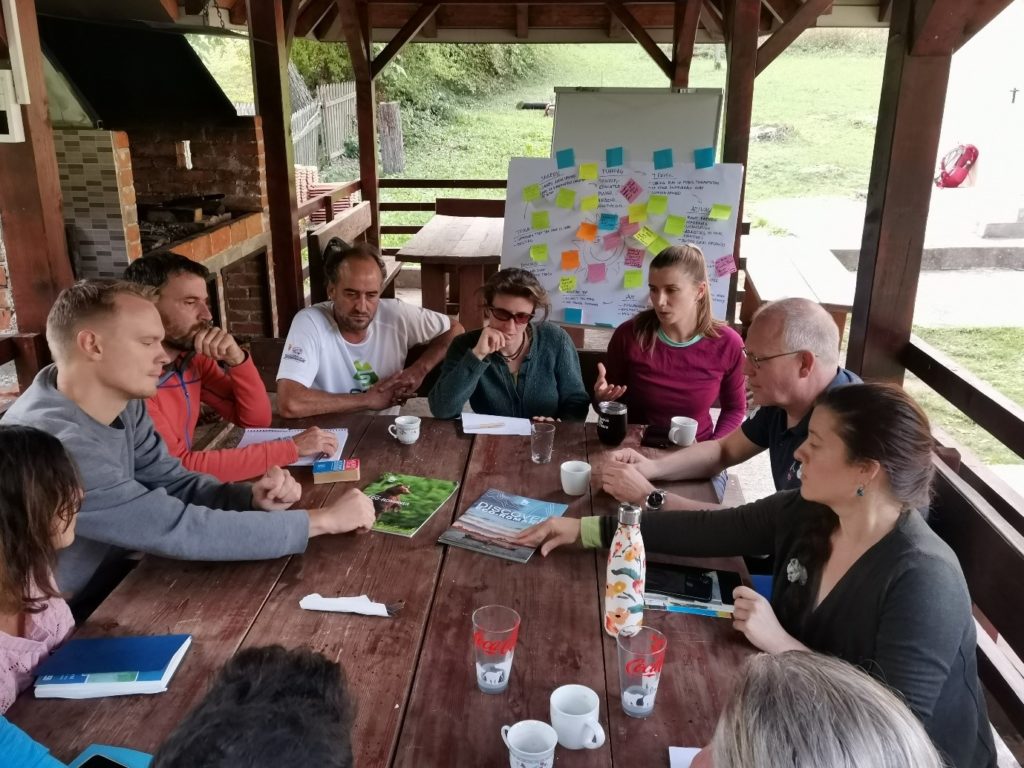
Meeting of the SEE Project partners in the TARA National Park, Serbia
In the 3-day programme, partners focused on exchanging methods to educate participants about responsible practices to minimize impacts on the natural environment, especially for outdoor sports involving mountainous terrains, such as mountaineering and hiking. In addition, participants also discussed how planning and good preparation for any outdoor activity are essential in order to avoid environmental impacts and accidents.
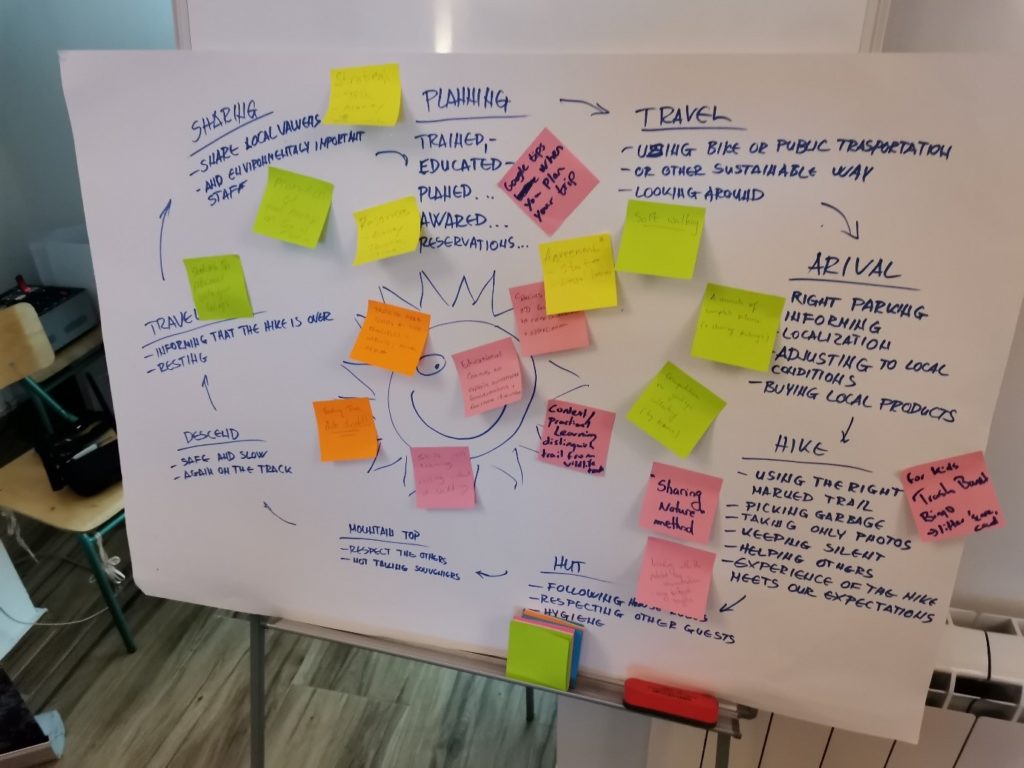
Meeting of the SEE Project partners in the TARA National Park, Serbia
Furthermore, one of the topics discussed was the time needed for various types of waste and materials to degrade. Leader of the SEE project, Leave no Trace, Ireland, produces educational material on this subject. For instance, the Outdoor Ethics Guide for Trainers provides great guidance on this topic.
Additionally, as a basic set of rules for responsible conduct in all outdoor sports in Protected Areas, the 10 Good Principles for Outdoor Sports in Protected Areas were introduced. These principles are available in 7 different languages.
Endorse the 10 Good Principles
You can support and contribute to the implementation of the 10 Good Principles in several ways:
- Show the 10 Good Principles on your website. Visitors who prepare their trips will be better informed.
- Disseminate information on social media. Use your network to spread the word!
- Use your visitor centre to show and talk about the principles during the visits.
- If you organise or participate in an outdoor sports event, make sure participants know the principles before the activity starts.
- When working with young people, teach them and highlight the importance of respecting these principles. Five minutes of teaching can develop into many years of good practice.
- Talk and spread the word to anyone interested, in any way. All diffusion is important!
Keep in mind that although this behaviour may be obvious, it is not so common in outdoor sports. Your participation is crucial to preserving our natural heritage.
Download The Good Principles for Outdoor Sports:
EN10 PRINCIPLES FOR OUTDOOR SPORTS
FR 10 PRINCIPLES FOR OUTDOOR SPORTS
DE 10 PRINCIPLES FOR OUTDOOR SPORTS
ES 10 PRINCIPLES FOR OUTDOOR SPORTS
CZ 10 PRINCIPLES FOR OUTDOOR SPORTS
IT 10 PRINCIPLES FRO OUTDOOR SPORTS
